A city for history buffs, adventurers and bargain hunters alike, Seville is the cultural, artistic and financial center of Andalusia, the southern region of Spain. It’s ideally located for day trips to the pristine beaches of Portugal only two hours away. The Costa de Sol, or the Sun Coast, 45 minutes away from Seville, stretches along the Mediterranean coastline on the Iberian Peninsula and includes some of gay-friendliest beaches in Western Europe. Morocco is a 15-minute ferry ride across the Straits of Gibraltar from Tarifa, just two hours south.
Seville boasts some of the most affordable nightlife, attractions and lodging in Europe. This old-world city retains a semi-conservative personality, but also offers gay visitors plenty of bars, restaurants and discos for hanging out and meeting up. Not coincidentally, Spain was the third European country to legalize same sex marriage between Spanish citizens and registered foreigners living in Spain.
Wandering the winding cobblestone streets of Seville, one can’t help but notice the Moorish influence on the amazing architecture. A small city with big city style, Seville’s citizens, or Sevillanos as the locals are called, are very welcoming. An eclectic blend of artists, writers, bohemians, hipsters, musicians, dancers and professionals, they are proud of their city, and it’s not hard to see why. In almost every building and alleyway, visitors are bound to encounter dancing and singing to the famous style of flamenco known as Sevillanas. Seville is a place where the party never ends; families, friends and lovers take to the streets during siesta to enjoy a cold glass of Cruzcampo, the local beer, or a Tinto de Verano, a mix of red wine iced down with orange or lime Fanta.
WHAT TO DO
Seville has numerous historical sites to visit during the day. The gothic Catedral de Santa María de la Sede (Avenida de la Constitución, Plaza Virgen de los Reyes) is the largest in Spain and the third largest in the world. Built on the site of a Moorish mosque during the reconquista, it now serves as the burial site of Christopher Columbus.
The Seville Alcázar (Plaza Patio de Banderas) is located just a brief walk from the Cathedral. Once a Moorish fort, it still serves as the royal residence. This medieval Islamic palace is a perfect representation of the history of Seville, showcasing Spanish Christian, Jewish and Moorish architecture. Exploring the gardens, orange groves and centuries-old buildings hidden away in this palace could easily take half a day.
The famous Murillo Gardens in the center of the city offers beautiful landscapes, architecture, sculptures, fountains and Spanish tiled benches from which to admire the luscious vegetation.
Seville’s beauty truly shines in the spring. Semana Santa, or Holy Week, occurs during the last week of Lent and is an unforgettable cultural experience. Don’t be fooled by its religious origins; throughout the processions that go on all day and into the evening, people line the streets celebrating, drinking and awaiting the passing of their favorite religious statues as marchers carry them down the streets.The Feria de Abril (last week of April into the first week of May) is another must—a weeklong party that includes drinking, dancing and par- tying during which beautiful women dress in traditional flamenco costumes for their performances. For a real taste of Seville, don’t miss these two huge celebrations.
Everybody needs art in their lives, and Sevillanos get their fix at the Museo de Bellas Artes (Plaza del Museo 9). The magnificent building, constructed in 1662 as a convent, now showcases work by Sevillian artists including masterpieces by Goya, Bartolomé Esteban Murillo and baroque paintings by Jusepe de Ribera.
WHERE TO SHOP
Shopping is a must in Seville. Stores are generally open from 9am to 2pm, then close for siesta and reopen from 5pm to 9pm. Yes, siesta really does exist!The main shopping district on the neighboring streets of Sierpes and Tetuan contains thick rows of shops. With a mix of chain stores, local artisan markets and distinctive boutiques, shopping is a favorite pas- time for locals and tourists alike in Seville. Consumers can find everything from fancy high-end stores showcasing the latest Burberry coat to inexpensive open-air crafts markets or trendy stores such as H&M and Zara.
The thrifty yet spectacular outdoor Art Market Plaza de Museo (Plaza del Museo 9; Sundays only) showcases paintings, photos, sketches and handmade crafts by local artists and students from the Art Academy. Prices start at an affordable 10 euros and go up. Few visitors leave Seville without purchasing a unique piece to take home and show off to friends.
Knick-knack fanatics head for the gypsy market at the Mercado de Calle Feria. Locals have been setting up shop every Thursday for hundreds of years on this lively street to sell antiques, furniture, ceramics, fixtures, paintings, coins, stamps, glassware, accessories, old home video game systems, computer parts, books, clothing, toys, posters and many other magical items that aren’t found anywhere else.
At the eccentric outdoor hippie market Plaze de Duque (Plaza del Duque de la Victoria, 8; Thursday-Sunday) one can purchase scarves, pins, bags, tapestries, jewelry, leather goods and other miscellaneous items with plenty of local flavor.
WHERE TO EAT
Attention all foodies! Fans of delectables like Iberian ham, local cheese, juicy olives, fresh crisp artisan bread and smooth wine will find Shangri-La in Seville. With so many choices of incredibly rich foods, tapas are the only way to order. Tapa refers to the small size of the dish—it’s the perfect way to try a little of everything, and get your fill without emptying your wallet.
Los Coloniales (Plaza Cristo de Burgos 19, tabernacoloniales.es) serves only the most delicious local tapas in large portions for a reasonable price. Expect to spend about 20 euros on a meal, including a bottle of wine.
Borreas (Alameda de Hercules, 61) turns tapas into trendy art with a focus on radical presentations of fresh ingredients. The apple lasagna, fresh meat dishes and hearty salads will not disappoint, especially for the price.
Trajano Cafe 3 (Calle deTrajano 3) is the most gay-friendly tea, coffee and cocktail lounge in town. Gay publications are available here for free.
La Giganta (C/Alhóndiga, 6) is located across from an old crooked church. You can sit out- side soaking up the Spanish sun and partake in a variety of homemade mousses, pâtés, fresh-baked bread and cheeses.
Rayas (Calle Reyes Católicos) has such amazing gelato you would swear you were in the heart of Italy. It’s always packed full of people taking a break from the sun and looking to cool down.
La Bohemia (Calle Amor de Dios 44) is a laid- back authentic Moroccan tea room offering sweet hookah flavors and a large variety of soothing tea blends. Local art for sale is dis- played on the walls, and there’s a tea room on the second floor for lounging.
Caso Paco (Alameda de Hércules 23) is so off the beaten path it’s a local secret, and is perfect for people watching in the poplar- shaded park.
Street Bar (Calle del Amor de Dios, 64) is located on a sun-soaked corner in the Alameda, and is the perfect spot to take a break and recharge with a cup of scrumptious coffee.
O’tapas Albahaca (Calle Pages del Corro 119) is one of the best places to get traditional tapas. They’re known for their fresh fish and large portions.
WHERE TO PARTY
The party for your typical Sevillano gets hopping at about 2am. That’s not to say there is nothing for the early birds, but things are best after dark. The popular neighborhoods for gay nightlife are the Alameda de Hercules and Calle Torneo, just across the river Gualdaquivir. You have your choice of the big, gaudy discotecas that tend to be overpriced, or your cozy neighborhood bar where a night out will only cost about 20 euros.
Sacha (Calle San Francisco) is Seville’s international lesbian haven. Picture a large room with professional dancers, several DJs working their tables and lesbians stomping on the dance floor. The party doesn’t start until 3am, so be sure to take advantage of your siesta during the day.
Itaca (Calle Amor de Dios 31) is Seville’s oldest gay bar. The crowd is a mix of gay boys, girls and memorable drag queens. La Caja Negra (Calle Fresa 15) is a well-hidden bar known for its great music in the evenings, which echoes off the walls lined with film and political posters. Hercules y Mitico (Calle Alameda de Hercules, 93) is a small gay bar attracting boys, girls and cross-dressers displaying music videos on flat-screen TVs. This is a great place to escape the tourist traps and get to know the gay locals.
Isbiliyya/El Paseo (Paseo Cristobal Colon) are two neighboring bars situated across from the river Guadalquivir. They are quite gay-friendly and are open every day. Patrons can hop back and forth to see beautiful boys and girls dancing on two floors to the latest beats.
Noveccento (Calle Julio César 10, noveccento.com) is a chic trendy indoor/outdoor bar attracting plenty of lesbians. They are known for their themed fiestas celebrating women and diversity.
El Barón Rampante (Calle Arias Montano, 3) is open daily from 8pm to 3am and weekends from 4pm to 3am. This is a good bar for the ladies who don’t want to start the party too late. Jackson (Calle Relator 21, Alameda de Hercules), on the other hand, is for those who want to continue the party into the wee hours of the morning.This hotspot is always packed to the brim with dancers.
WHERE TO STAY
Hotel Nuevo Suizo (Calle Azofaifo 7, EUR 21–99, nuevosuizo.com) is a trendy but affordable hostel decorated in modern Andalusian décor. It offers single, double and triple rooms, private terraces and free bed linens and towels. Breakfast and free Internet access are also included.
Petit Palace Santa Cruz (Calle Muñoz y Pabón 18A, EUR 75–180, hotelpetitpalacesantacruz.com) is a 17th-century mansion located in Barrio Santa Cruz. Amenities include free use of laptop computers with complimentary Internet access.
Patio de la Alameda (Plaza Alameda De Hércules 56, EUR 80–4,160) used to be the home of Spanish nobility and has been transformed into a spacious apartment-style hotel with three large courtyards.The hotel is perfectly located for checking out some of the city’s best bars and restaurants.
The Eurostar Regina (San Vicente 97, EUR 50–130, eurostarshotels.com is a modern three-star hotel located near El Centro. They have bicycle rentals available so you can zip around town and take in all the sites. Rooms overlook an Andalusian courtyard.
The Hotel Alcántara (Calle Ximenez de Incisco 28, EUR 50–90) is an 18th-century mansion with a unique blend of antiquated and modern styles under one roof. It is centrally located in the Barrio Santa Cruz, next to the Murillo Gardens.
Hotel Alfonso XIII (Calle San Fernando 2, starwoodhotels.com, prices start at EUR 300) is a Moorish inspired hotel in the heart of Barrio Santa Cruz featuring an outdoor pool and garden space. If you don’t want to dish out the cash for a five-star hotel, you can enjoy a scrumptious Sunday brunch here.

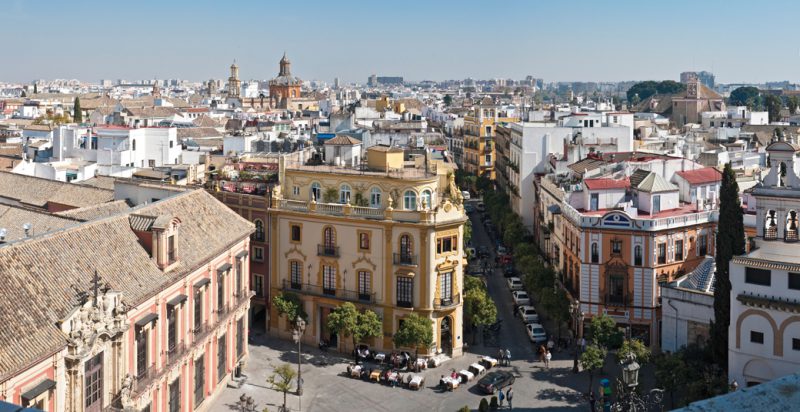


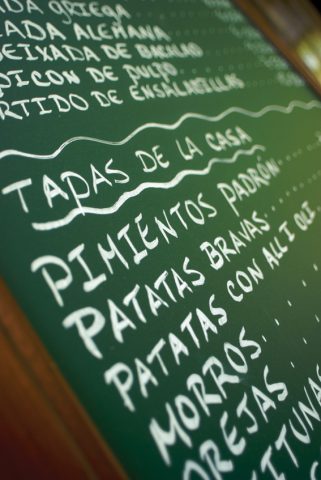
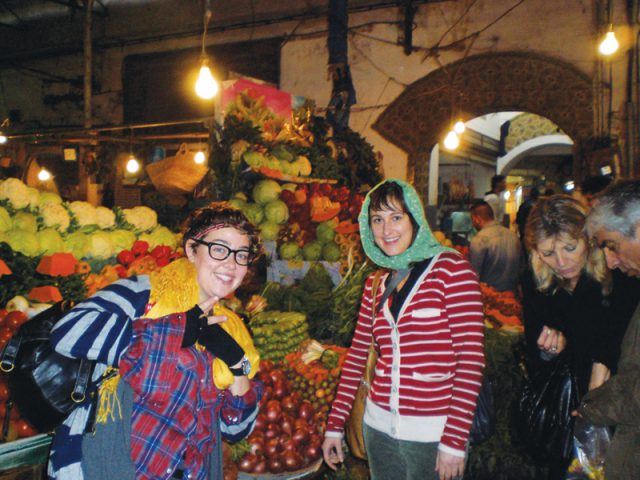
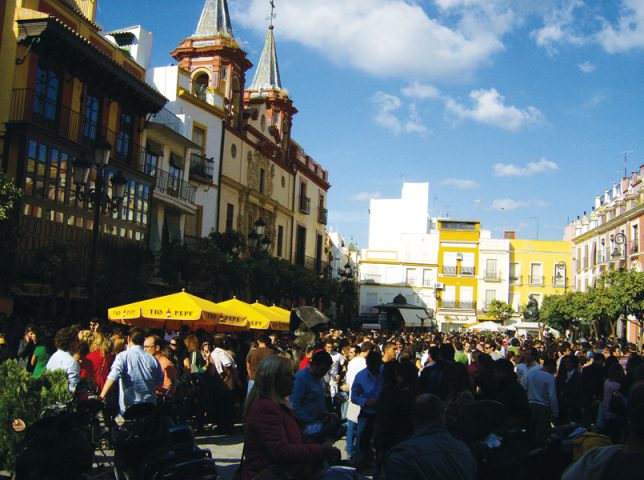
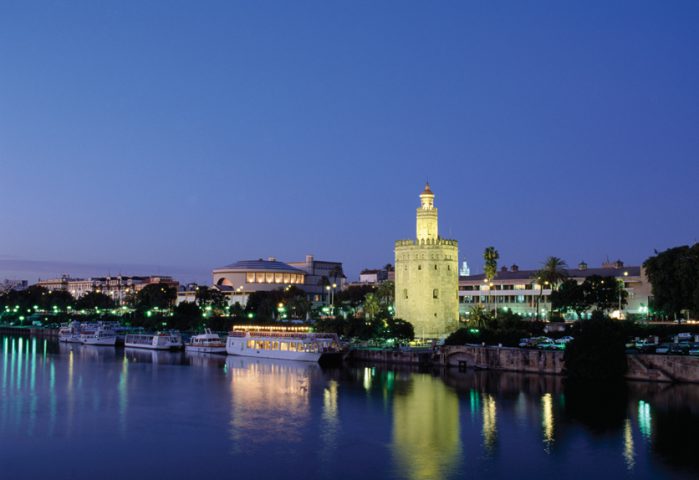


What Do You Think?